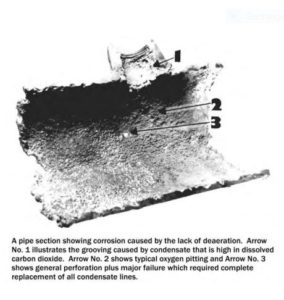
IS A DEAERATOR REALLY NECESSARY?
The following is an excerpt from an article that first appeared in an Industrial Newsletter some time ago. The full title for the article was “Is a Deaerator Really Necessary -or- How to Return Your Piping System to the Boiler”.

From time to time we hear the question, “Why do we need a deaerator, we’ve been operating for twenty years without one?” Or, How can you justify the extra expense of a deaerator over a standard inexpensive boiler feed system?” It is difficult to argue with this type of reasoning because a deaerator is a long-term investment with variable pay off. But pay off there is!
Now we are going to tell you something that may shock you. Under the proper conditions, it is theoretically possible for one pound of oxygen to combine with four pounds of iron (iron oxide…Rust!) This is not to say it is a promised fact but merely a probability. Along with Carbon Dioxide in the steam, the chances become four (4) times greater of achieving this theoretical balance. This means it is possible for the oxygen in 16 GPM of water to remove, oxidize and/or dissolve nearly 50 pounds of iron per week. Where does the iron pipe go? It comes back to the return line, to the feed system, pumped into the boiler and then blown down to the sewer. There goes your piping system, boiler, expensive heat exchangers and other system components…Down the sewer!
If you, or the contractor, or the customer, or the engineer, think you can short cut an over-budgeted job by ignoring the laws of nature, you are fooling yourselves…but don’t try to fool Mother Nature…She will get you eventually! What you end up doing is making your boiler and piping system a deaerator because the oxygen and carbon dioxide are going to react someplace…the laws of nature demand it.
YOU ARE NOT DOING ANYONE A FAVOR WHEN YOU LEAVE OUT THE DEAERATOR…SPECIFY A QUALITY DEAERATION SYSTEM AND SLEEP AT NIGHT.
ADVANCED TECHTIPS…We have several articles that go into deaerator selection, sizing and operation in great detail. Contact our office for further information.